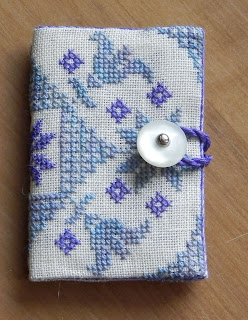 Pour la grille de broderie utilisé dans ce tutoriel, voir ICI.
Pour la grille de broderie utilisé dans ce tutoriel, voir ICI.For the embroidery pattern used in this tutorial, see HERE.
Voor het borduurpatroon dat in deze werkbeschrijving wordt gebruikt, kijk HIER.
Coupez votre broderie jusqu'à 6" x 7" = 15 x 17,5 cm et le tissu pour l'intérieur (et la bordure) jusqu'à 6" x 8" = 15 x 20 cm
Cut your embroidery to 6" x 7" and your lining fabric (and trim) to 6" x 8"
Knip het borduurwerk tot 6" x 7" = 15 x 17,5 cm en de stof voor de voering (en het randje) tot 6" x 8" = 15 x 20 cm
Ensuite il faut coudre les côtés court ensemble avec les tissus placés endroit contre endroit, jusqu'à obtention d'un tunnel comme ceci.
Then you have to stitch the short sides together with the right sides of the fabric together, until you have a tunnel like this.
Vervolgens stik je de korte zijden samen met de goede kanten van de stof tegen elkaar, tot je een tunnel als deze hebt.
Tournez le tunnel et repassez du milieu à l'extérieur, et vous obtenez une bordure à chaque côté.
Turn the tunnel inside out and press from the middle to the side to get a trim on either side.
Draai de tunnel binnenste buiten en strijk van het midden naar de buitenkant tot je een randje aan elke kant hebt.
Maintenant il faut plier les extrémités jusqu'au milieu, comme sur la photo.
Now you have to fold the extremities to the middle, as shown in the picture.
Nu moet je de uiteinden naar het midden vouwen, zoals op de foto te zien is.
Les côtés ouvertes sont cousu fermé avec un point droit et ensuite avec un point zig zag, pour empêcher le tissu de s’effilocher (ou si ta machine a un point qui fait ça tout de suite, tant mieux !)
The open sides are stitched closed with a straight stitch and the with a zigzag stitch, to keep the fabric from fraying (or if your machine can do this at the same time, it's even better !)
De open zijden worden dichtgestikt met een rechte steek en dan met een zigzag steek, om te voorkomen dat de stof gaat rafelen (of als jouw machine dat tegelijk kan, deste beter !)

Tournez l'endroit vers l'extérieur, ensuite un petit coup de repassage....
Turn the right side out, then press it until nice and flat.....
Draai de goede kant naar buiten, strijk het geheel goed glad.....
Remplissez la pochette avec vos mouchoirs en papier favorits, et le tour est joué !
Fill the tissue holder with your favourite paper tissues, and it's ready !
Vul het etui met je favoriete papieren zakdoeken, en het is klaar !

















































